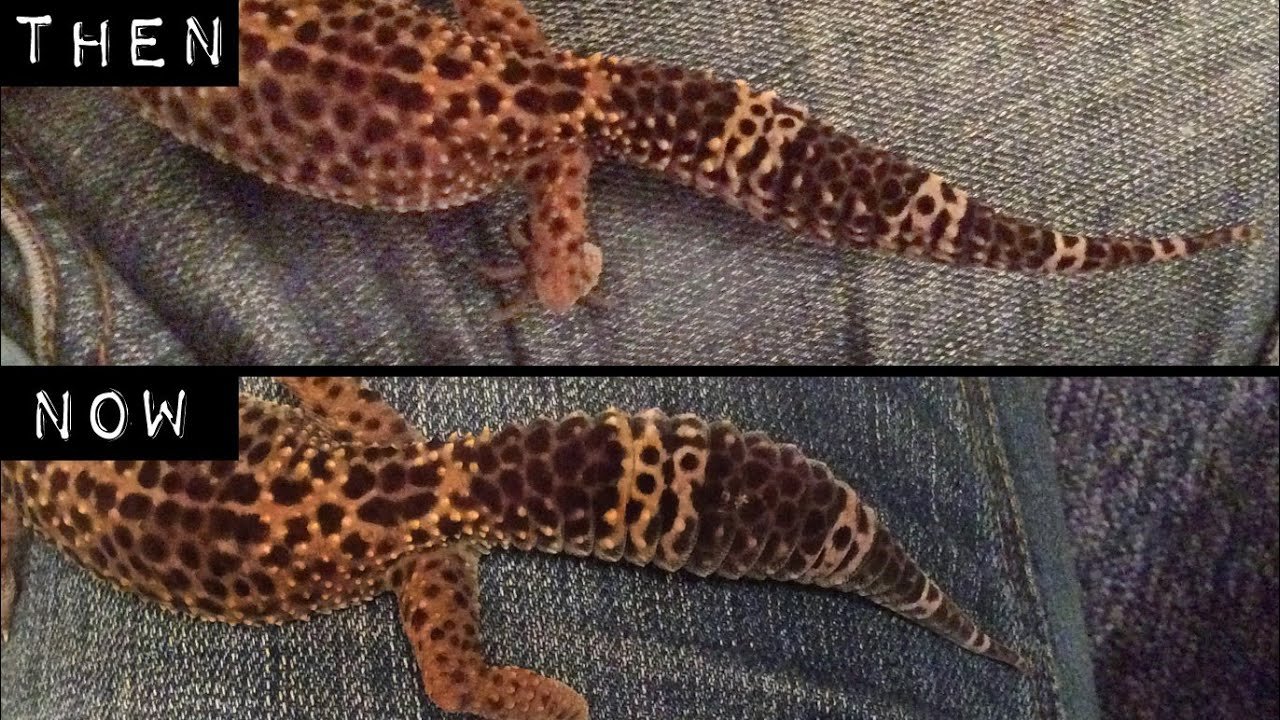How Fat Should a Leopard Gecko Tail Be

A healthy leopard gecko tail should be about the same width as the body at its base. The tail should taper to a point and be free of kinks, bumps, or other abnormalities. If your leopard gecko’s tail is significantly thinner than their body, it may be a sign of malnutrition.
There’s no definitive answer to this question, as leopard gecko tails can vary somewhat in size and girth. However, a healthy leopard gecko tail should generally be thick and muscular, tapering to a point at the end. It shouldn’t be excessively skinny or malnourished looking, nor should it be so fat that it appears bloated or unhealthy.
If you’re unsure whether your leopard gecko’s tail is the right size, ask your veterinarian for guidance.

Credit: www.reddit.com
Are Leopard Geckos Tails Supposed to Be Fat?
No, leopard geckos tails are not supposed to be fat. A healthy tail should be long and thin, tapering to a point. If your leopard gecko’s tail is fat, this could be a sign of metabolic bone disease or other health problem.
If you are concerned about your leopard gecko’s health, please take it to a reptile veterinarian for an examination.
Can a Leopard Gecko’S Tail Be Too Fat?
A leopard gecko’s tail can be too fat if the animal is obese. An obese leopard gecko will have a larger than normal tail, and this can cause problems for the animal. The extra weight on the tail can make it difficult for the leopard gecko to move around, and it can also put pressure on the animal’s spine.
If a leopard gecko’s tail is too fat, it is important to help the animal lose weight so that it can be healthy and mobile.
What Should a Healthy Leopard Gecko’S Tail Look Like?
A leopard gecko’s tail is an important part of their body and plays a vital role in their health and well-being. A healthy leopard gecko’s tail should be long, thick, and tapering to a point. The tail should be free of any bumps, lumps, or irregularities.
The color of the tail should be a uniform brown or tan with no dark spots or stripes. If you notice any changes in your leopard gecko’s tail, such as it becoming thinner, shorter, or changing color, this could be an indication of a health problem and you should take them to see a veterinarian as soon as possible.
What Does a Skinny Leopard Gecko Tail Mean?
A skinny leopard gecko tail can indicate that the animal is not getting enough food or nutrients. It can also be a sign of dehydration. If you see your leopard gecko with a skinny tail, it’s important to take him to the vet for a checkup.
Leopard Gecko Loses Tail
How Big Should a Leopard Gecko Tank Be
Leopard geckos are one of the most popular reptile pets. They are small, hardy and relatively easy to care for. One of the key things you need to provide your leopard gecko with is a suitable habitat.
In this article we will discuss how big a leopard gecko tank should be.As a general rule of thumb, a leopard gecko tank should be at least 20 gallons (75 liters) in size. This is for a single adult leopard gecko.
If you are keeping more than one leopard gecko then you will need to increase the size of the tank accordingly. For every additional leopard gecko you should add 10 gallons (40 liters) to the size of the tank. So, for two leopard geckos you would need a 30 gallon (115 liter) tank, and for three leopard geckos you would need a 40 gallon (150 liter) tank etc.
It is important to note that these sizes are minimums. Ideally, you should provide your leopard geckos with as much space as possible within reason. The larger the enclosure the better as this will give your pet more room to explore and exercise which is beneficial for their overall health and wellbeing.
It also reduces stress levels and can help prevent aggression between multiple reptiles housed together.
Leopard Gecko Tail Fat
Leopard geckos are a type of lizard that is native to parts of Asia and Africa. They are known for their ability to change the color of their skin to blend in with their surroundings. Leopard geckos are also known for their long tails, which they use to help them balance while they are climbing.
One thing that you may not know about leopard geckos is that they have a layer of fat stored in their tails. This fat helps to keep the gecko warm and provides energy in case of food shortages. It also helps the gecko stay hydrated by absorbing water from the air.
So why do leopard geckos have such chubby tails? Well, it turns out that this extra layer of fat provides many benefits to the gecko. In the wild, having a little extra padding can mean the difference between life and death.
And in captivity, this extra weight can help keep your leopard gecko healthy and happy!
Healthy Leopard Gecko Vs Unhealthy
If you are new to leopard geckos or just want to make sure your leopard gecko is healthy, this article is for you! Here we will discuss what a healthy leopard gecko looks like, as well as some common health problems that can affect these lizards. By the end of this article, you should have a good understanding of how to tell if your leopard gecko is healthy and what to do if you think there may be a problem.
A healthy leopard gecko should have clear eyes, smooth skin, and a plump tail. Their nails should be trimmed and their vent should be clean. They should be alert and active, with a good appetite.
If you notice any of these signs changing suddenly or dramatically, it could be an indication of a health problem and you should take your lizard to the vet right away.Some common health problems in leopard geckos include respiratory infections, mouth rot, parasites, impaction, and kidney disease. Respiratory infections are usually caused by bacteria and can cause symptoms such as wheezing, sneezing, loss of appetite, lethargy, and difficulty breathing.
Mouth rot is another bacterial infection that affects the mouth area causing ulcers and lesions. If left untreated it can spread to the rest of the body causing severe illness. Parasites are often picked up from eating live food or from contact with contaminated substrate.
Symptoms of parasites include weight loss, diarrhea , vomiting , lethargy ,and anemia . Impaction occurs when your lizard ingests something they cannot digest properly which then gets stuck in their digestive tract; common causes include sand substrates , calcium deficiencies ,and dehydration . Kidney disease is typically seen in older lizards and can cause increased thirst/urination , weight loss ,anorexia ,and lethargy .
Does a Leopard Gecko’s Tail Size Affect Its Ability to Regulate Body Temperature?
A leopard gecko’s tail size plays a crucial role in regulating its body temperature, especially in a hot temperature for leopard geckos. The tail acts as a reserve for storing fat, which helps the gecko cope with extreme heat. A larger tail allows for better heat absorption and dissipation, enabling the gecko to maintain a stable body temperature in challenging environmental conditions.
Leopard Gecko Fat Belly Skinny Tail
If you have a leopard gecko with a fat belly and skinny tail, there’s a good chance something is wrong. This could be due to several different issues, so it’s important to take your pet to the vet for an exam as soon as possible.One possibility is that your leopard gecko has been overfed and is now obese.
Obesity can lead to all sorts of health problems, including diabetes, joint pain, and respiratory difficulties. If this is the case, your vet will put your pet on a diet and help you create a healthy feeding schedule.Another possibility is that your leopard gecko has parasites.
These tiny creatures can steal vital nutrients from their host, causing weight loss and malnutrition. If this is the case, your vet will prescribe medication to kill the parasites and help your pet regain its health.Finally, there could be an underlying medical condition causing your leopard gecko’s weight loss.
Conditions like kidney disease or cancer can cause weight loss even if the animal is eating normally. Your vet will run tests to rule out any serious illnesses and develop a treatment plan accordingly.
Conclusion
A leopard gecko’s tail should be about the same size as its body. If it is much larger, it may be a sign of obesity, which can lead to health problems. If it is much smaller, it may be a sign of dehydration.